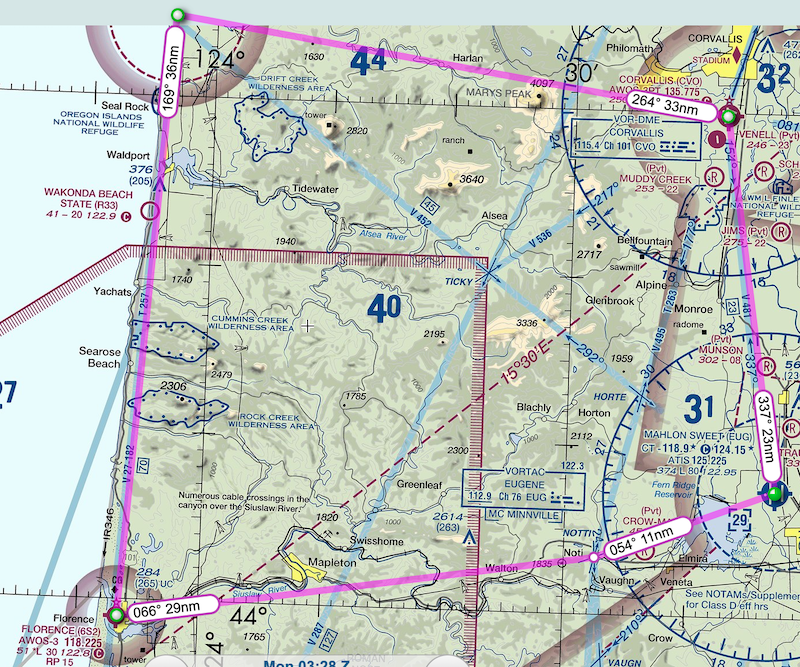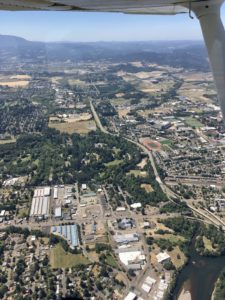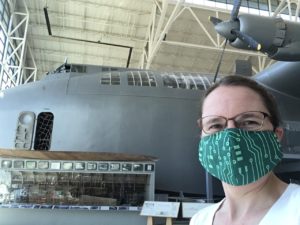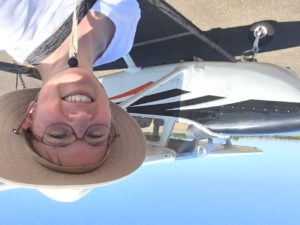Flying “under the hood” to another airport (no peeking!)
September 1st, 2022 at 5:40 pm (Flying)
For my second instrument training lesson (August 14), I got to fly to another airport wearing a “view limiting device” that blocks all peripheral vision so all you can see is the instrument panel in front of you. Your view is something very like this:

For this flight, we took off from Corvallis (KCVO) and flew to a nearby intersection in the air (SHEDD), then turned south for our destination, Hobby Field (Creswell, 77S).
I had filed the flight plan beforehand, and we got our clearance to 77S in the air. I then learned about the next step, which is to get the current weather at 77S and then request a particular approach to your destination. In this case, we asked for “the RNAV 16 approach to Creswell, to full stop, starting at ALFOR.”
While heading to ALFOR and maintaining your course and altitude and airspeed and five other things, you brief (talk through) your approach. One mnemonic to help you along is MARTHA:
- Missed approach: what to do if the clouds are too low for you to land (or winds or turbulence or any other reason you’d rather not do it right then)
- ATIS (weather) and Altimeter setting
- Radios set so we can talk to the right people and navigate to the right destination
- Time: in case it’s a timed approach (this one isn’t)
- Heading: to get aligned with the final approach, 159 degrees (southeast)
- Altitude: start at or above 3800′, then descending as indicated on the approach plate
At ALFOR, you begin following a series of named waypoints that allow you to get progressively lower until you can line up and land. These all have 5-letter names, and the RNAV 16 approach sequence begins to feel like a magic charm: ALFOR, IYAYE, WOSLO, ZEMAM, UWZAB. Somewhere after here, my instructor declared that we’d broken through the “clouds” and I could remove my hood and land the plane. The approach brings you in lined up for runway 16 (headed south), but the wind was from the north, so we did a “circling” approach, which just meant flying into the downwind for runway 34 and landing normally. If the clouds don’t magically clear before you descend to (in this case) 1041′, you execute the “missed approach” to fly away and either try again or go elsewhere to land.
We departed using the HOBBY TWO obstacle departure procedure, which is designed to keep you safe from the surrounding hills (although note the extensive list of trees, poles, fences, etc.!). I put the hood on while we were climbing out, so I couldn’t see the hills anyway. (Which is okay because my instructor was watching them carefully :) ) We then flew back to KCVO, along the way requesting the RNAV 35 approach there. The associated magic incantation is DERAY, WENKA, ACOTY, CESDO. This time we flew the approach from DERAY, then pretended that we were still in clouds so did the missed approach back to DERAY, and flew it again.
Flying with the hood on is challenging. It took all of my concentration to try to keep the plane on the heading to the airport, descending at the correct rate, good airspeed, etc. There’s so much that you subconsciously process and respond to when you can see the world outside your plane! When that is taken away, you have to stare at the dials and reconstruct your spatial position and trajectory and translate that into the right control adjustments – pitch, power, bank, and rudder. On our first approach to runway 35, I ended up offset from the actual runway (when finally allowed to look!), but the second approach was much better (and that’s the one we landed from). I’ll keep working on refining it!










